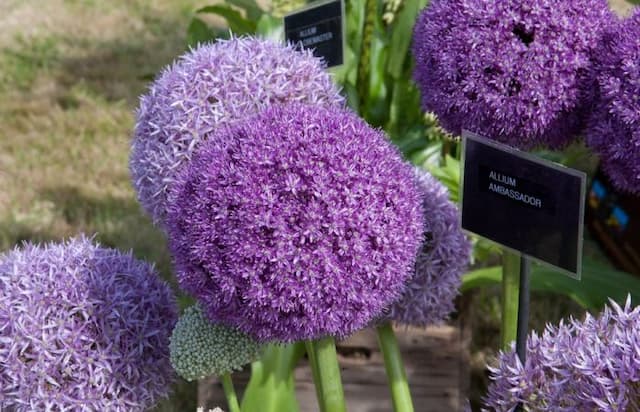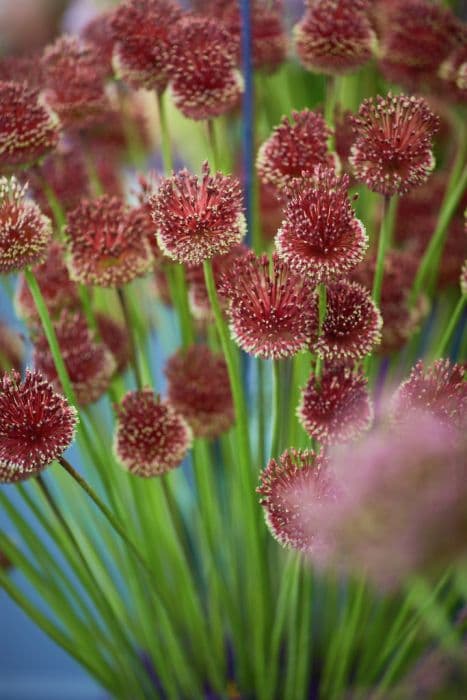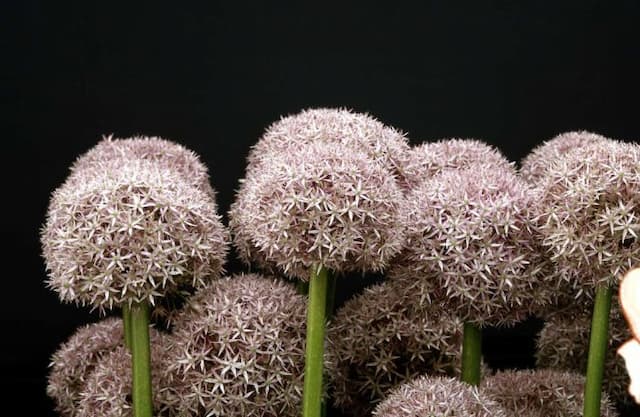Persian Shallot Allium jesdianum 'Akbulak'

ABOUT
Allium jesdianum 'Akbulak', commonly known as ornamental onion, is a striking plant that features a distinctive bloom shape and appearance. The plant bears large, spherical flower heads that are made up of numerous small, star-shaped flowers. These blooms possess a rich and vivid color, usually a deep purple or burgundy hue, providing a bold contrast to the green foliage below. The leaves of the ornamental onion are typically strap-shaped, creating a lush and dense base for the flower heads. They are a bright green color, adding to the fresh appearance of the plant. As the bloom season progresses, these leaves might begin to wither, directing more focus to the impressive globular blooms. The stems of the Akbulak variety are strong and upright, holding the flower heads aloft with elegance. They emerge from a bulb that is planted in the soil, which allows the plant to return year after year. The overall structure of the plant is both tidy and architectural, with the blooms creating a focal point in any garden setting. The ornamental onion is appreciated for its ornamental value, adding height, color, and texture to garden beds, borders, and arrangements. Its striking appearance often attracts pollinators such as bees and butterflies, adding an extra layer of life and movement to its surroundings.
About this plant
 Names
NamesFamily
Amaryllidaceae
Synonyms
Akbulak Ornamental Onion, Jesdianum Allium
Common names
Allium jesdianum 'Akbulak'.
 Toxicity
ToxicityTo humans
Ornamental onion is generally not considered poisonous to humans. Most members of the allium family are actually edible and used in cooking. However, consuming large quantities of the plant, especially the bulb, could potentially cause digestive discomfort due to the presence of various sulfur compounds.
To pets
Ornamental onion is toxic to pets, especially cats and dogs. Members of the allium family can cause oxidative damage to red blood cells leading to hemolytic anemia. Symptoms of poisoning may include vomiting, diarrhea, abdominal pain, weakness, and elevated heart and respiratory rates. In severe cases, ingestion can lead to lethargy, collapse, and in some instances, it can be fatal if not treated promptly.
 Characteristics
CharacteristicsLife cycle
Perennials
Foliage type
Deciduous
Color of leaves
Green
Flower color
Purple
Height
2 feet (60 cm)
Spread
1 foot (30 cm)
Plant type
Bulb
Hardiness zones
4
Native area
Asia
Benefits
 General Benefits
General Benefits- Ornamental Appeal: Allium jesdianum, commonly known as the Persian Onion, features striking globular purple flowers that add a visual interest to any garden.
- Attracts Pollinators: Its blossoms are a magnet for bees, butterflies, and other beneficial pollinators, which are crucial for the health of the ecosystem and aid in the pollination of other plants.
- Low Maintenance: Persian Onion is known for being drought-resistant and generally requires minimal care, making it a good choice for gardeners looking for low-maintenance plants.
- Deer and Rodent Resistant: The plant has a naturally occurring resistance to deer and rodents, reducing the likelihood of damage from these animals.
- Culinary Use: While not directly emphasizing medicinal properties or air purification, the plant belongs to the Allium family and some parts can be used in cooking for their onion-like flavor.
- Seasonal Interest: It provides seasonal interest with its late spring to early summer blooms, filling a bloom gap in gardens after the spring bulbs have faded.
 Medical Properties
Medical PropertiesThis plant is not used for medical purposes.
 Air-purifying Qualities
Air-purifying QualitiesThis plant is not specifically known for air purifying qualities.
 Other Uses
Other Uses- Allium jesdianum 'Akbulak', also known as Ornamental Onion, can be used to create natural dye, with different parts of the plant yielding varying shades on fabrics.
- This plant's sturdy stems make it suitable for crafting homemade plant stakes or supports for other, more delicate flowers in the garden.
- The dried flower heads can serve as unique additions to floral arrangements or can be used in dried wreath making.
- Since Ornamental Onion has a strong scent, it can be used as a natural rodent repellent in gardens to protect other plants.
- The plant's seed pods can be collected and used as unique bullets in seed-dispersal experiments or educational activities.
- Allium jesdianum can be used in art projects, such as botanical prints or nature rubbings, due to its distinct flower shape.
- The fibrous leaves of Ornamental Onion can be used in crafts for making paper or natural twine.
- Children can use the hollow stems of Allium jesdianum for making simple whistles or tubes in outdoor play.
- The ornamental value of the plant makes it suitable as a living fence or border within landscape designs to create visual interest.
- Allium jesdianum 'Akbulak' can also be used as a tool for teaching horticulture and plant biology because of its interesting growth patterns and flower development.
Interesting Facts
 Feng Shui
Feng ShuiThe Ornamental Onion is not used in Feng Shui practice.
 Zodiac Sign Compitability
Zodiac Sign CompitabilityThe Ornamental Onion is not used in astrology practice.
 Plant Symbolism
Plant Symbolism- Unity and Humility: As a member of the onion family, Allium jesdianum 'Akbulak', commonly known as ornamental onion, often symbolizes unity due to its layers, representing the many parts that come together to create a whole. Its bulbous growth can also reflect humility, as it starts growth hidden beneath the soil.
- Strength and Patience: Ornamental onions, with their sturdy stems and capability to thrive in a variety of conditions, embody strength and the ability to withstand adversity. They also teach patience, as they bloom in their own time without haste.
- Good Fortune and Prosperity: In some cultures, these plants are believed to bring luck and financial success, as their globe-like blooms suggest fullness and wealth.
- Protection: Historically, alliums have been thought to ward off evil spirits and bad luck, likely due to their pungent aroma, which was believed to repel negative influences and provide protection to those around them.
 Water
WaterThe Ornamental Onion should be watered deeply to soak the soil thoroughly, then allowed to dry out slightly before the next watering. Generally, watering once a week with 1-2 gallons during the growing season is adequate, but this may vary with local climate conditions. During the dormant season or in cooler temperatures, reduce the frequency of watering. Overwatering can lead to bulb rot, so ensure the plant has well-draining soil. Adjust the watering schedule based on rainfall and check the soil moisture level regularly.
 Light
LightOrnamental Onion thrives in full sunlight, so the best spot for the plant is in an area where it receives at least 6 hours of direct sunlight each day. It can tolerate partial shade, but flowering may be reduced in less than ideal light conditions. Ensure the plant is positioned where it isn't overshadowed by larger plants or structures to receive unobstructed light.
 Temperature
TemperatureOrnamental Onion does best in temperatures between 50°F and 80°F. It can withstand colder temperatures down to about -5°F, making it suitable for many temperate climates. In extreme heat above 90°F, the plant may require additional water to maintain moisture. It's essential to avoid exposing the plant to temperatures below freezing for prolonged periods as it can damage the plant.
 Pruning
PruningOrnamental Onion benefits from deadheading spent flowers to encourage new growth and prevent the plant from self-seeding excessively. Pruning can be done immediately after the flowers fade in early summer. Regular pruning is not necessary, but yearly removal of spent blooms and any damaged or withered foliage helps to maintain a tidy appearance and promotes healthy growth.
 Cleaning
CleaningAs needed
 Soil
SoilOrnamental Onion 'Akbulak' thrives in well-draining soil with a pH ranging between 6.0 to 8.0. A mix of equal parts loam, sand, and compost will ensure proper drainage and fertility. Amend the soil with organic matter to promote healthy growth. Avoid heavy, wet soils as they can cause bulb rot.
 Repotting
RepottingOrnamental Onion 'Akbulak' typically does not require frequent repotting. Repot it every 3-4 years or when you notice the clump becomes overcrowded. Dividing clumps in autumn is advised to maintain plant vigor and to propagate new plants.
 Humidity & Misting
Humidity & MistingOrnamental Onion 'Akbulak' is adaptable to a range of humidity conditions and does not require high humidity to thrive. Average room humidity is generally sufficient for this plant's growth.
 Suitable locations
Suitable locationsIndoor
Place in bright, indirect light and allow soil to dry between waterings.
Outdoor
Full sun to partial shade, in well-draining soil; water moderately.
Hardiness zone
4-9 USDA
 Life cycle
Life cycleAllium jesdianum 'Akbulak', commonly known as the Persian shallot, starts its life as a seed that germinates in well-draining soil under full sun or partial shade. The seed establishes a small bulb which gradually matures and sends up strap-shaped, green leaves. Following the leaf stage, a tall stem grows, culminating in a spherical cluster of star-shaped purple or magenta flowers during late spring to early summer. After flowering, the plant sets seeds that disperse to start a new generation, while the parent bulb enters a period of dormancy. During dormancy, the foliage dies back and the bulb remains underground until the next growing season, when it can produce new shoots and flowers. Some bulbs may also produce offsets, which are small daughter bulbs that can be separated from the parent to propagate new plants.
 Propogation
PropogationPropogation time
Spring to Summer
Allium jesdianum 'Akbulak', commonly known as Persian Onion, is typically propagated by dividing its bulbs. The best time to propagate by bulb division is in the late summer to autumn, after the foliage has died back and the plant is dormant. To propagate, carefully dig up the clump of bulbs and gently separate them by hand, ensuring that each division has at least one bulb scale with roots attached. After separating, the bulbs can be replanted immediately at a depth of three times the height of the bulb, which is usually around 6 inches (15 centimeters) deep, with spacing of about 8 inches (20 centimeters) apart to allow for adequate room for growth. This method of propagation is straightforward and helps to maintain the genetic characteristics of the parent plant while encouraging the growth of new plants for the next season.









